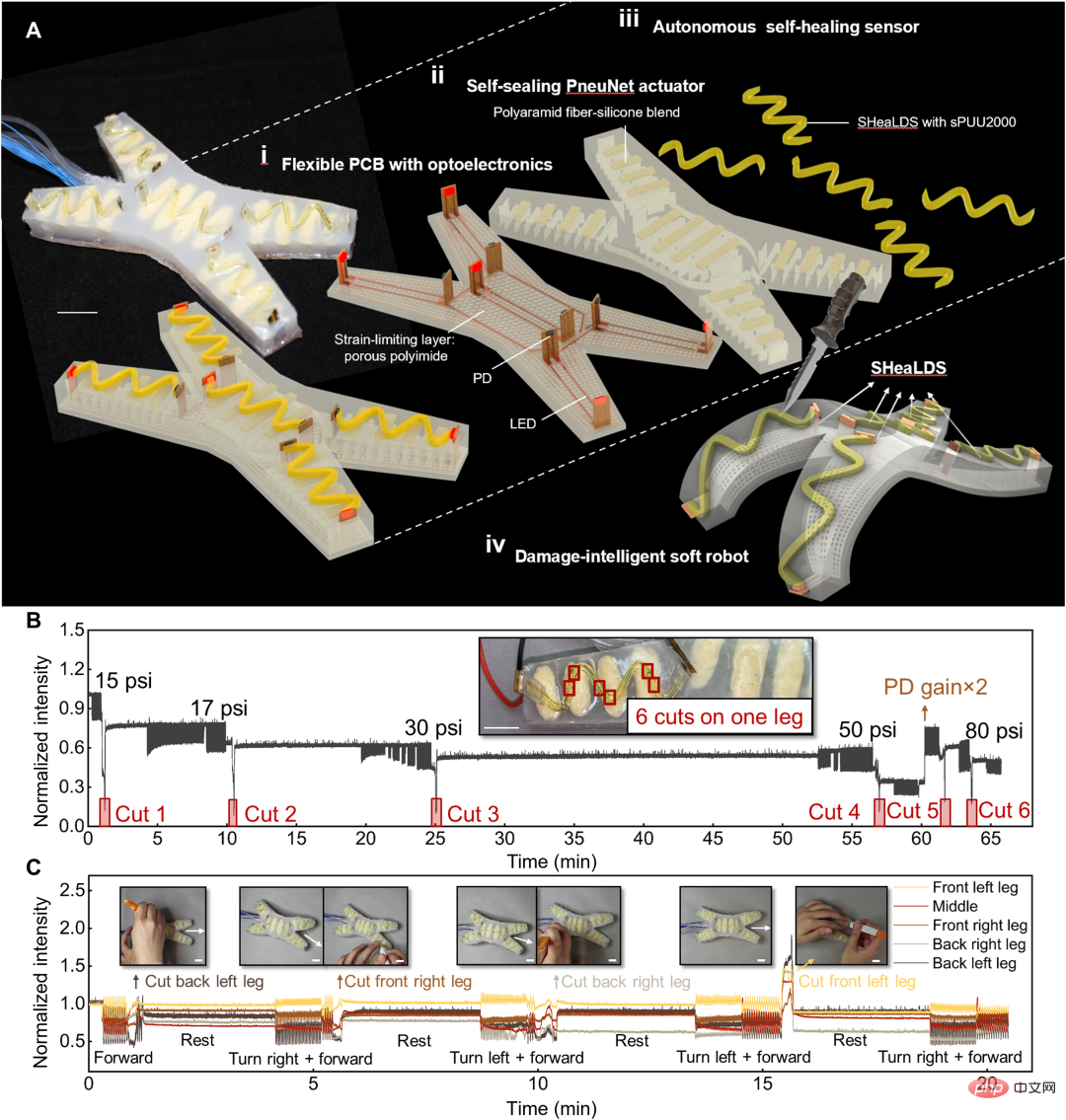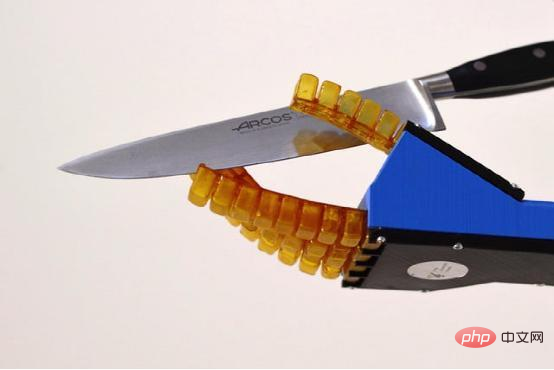Produced by Big Data Digest
Author: Caleb
##"The Terminator" has become a classic in the hearts of many science fiction movie fans.
In the movie, the robot T-800 eventually grows from an emotionless robot to a living being that understands human nature and life.
In addition to the image of the T-800 that is deeply rooted in the hearts of the people, the villain's liquid metal robot's ability to transform, imitate and repair itself is also deeply rooted in the hearts of the people.
# Recently, engineers at Cornell University are working to recreate this self-healing ability.
But their robot is not so scary, it even looks a little cute:
According to researchers It is said that these small soft four-legged starfish robots can use light to detect external damage and repair themselves on the spot.
As shown in the picture below, the researchers pierced one of the robot's legs six times. The robot then detected the damage and repaired each wound on its own in about a minute. And made an "escape" action, "like an animal's stress response."

This damage intelligence is crucial in some damage-prone environments important, such as space suits and supersonic parachutes in space, as well as applications where device life is a higher priority, such as wearable devices for human-computer interaction.
The team hopes to combine the robot with machine learning algorithms that can identify the different "tactile events" it may be exposed to.
Cornell University professor Rob Shepherd said: "Labs have been working hard to make robots more durable and agile so that they can work longer and be more powerful. ."
Relevant research has been published in the form of a paper on SCIENCE ADVANCES.

Paper link:
https://www.science.org/doi/10.1126/ sciadv.abq2104
The robot's self-healing is actually a chemical reaction
After the robot has been operating for a long time, damage will continue to accumulate .
For the robot to repair these damages by itself, some methods are needed.
Of course this is thanks to the compressed air pumped through the robot's body. The robot is covered in a layer of self-healing fiber optic sensors that are combined with LED lights that can detect small changes in its surface.
In fiber optic sensors, light from an LED is sent through a structure called an optical waveguide, which guides the beam in a certain direction.
The robot is also equipped with a photodiode that detects changes in light intensity to determine when and where the material is deformed.
To make the healing process more efficient, the researchers used polyurethane-urea elastomer, a transparent and elastic material, as the robot's "skin."

Because of this, when the robot is damaged, chemicals will occur on its exposed side. reaction, triggering the reorganization of interlocking polymer chains, allowing for self-healing.
This SHeaLDS technology (self-healing light guides for dynamic sensing) is the key to enabling an injury-resistant soft robot to self-heal wounds at room temperature without any external intervention .

Through the implementation of this self-healing technology, future robots can repair in specific environments Software systems such as space suits or underwater equipment hit by space debris.
The emergence of Terminator-style robots
The "Terminator" series of movies came into public view when they were released in 1984, and related technologies have also developed in recent years. Gradually it became popular.
In 2020, the U.S. Army Research Service and Northwestern University conducted research on related technologies. Researchers are trying to fuse synthetic materials with living biological organisms to realize the functions of the T-1000 robot. However, they say that its technical basis is different from that shown in the movie, and the robot's self-recovery speed is also slower.
Davanne Powley, polymer chemistry program manager at the U.S. Army Research Service, said in a report that "the ability to harness and engineer cellular devices to produce non-biological polymers will essentially transform artificial synthesis into Materials introduce areas of biofunctionality. This could enable advanced high-performance materials such as nanoelectronics, self-healing materials and other useful materials for the Army."
The process could have many additional uses, including creating materials to protect soldiers' bodies, fuel cells that can generate electricity, and various types of new electronic devices. Theoretically, it can last longer than current equipment.

##In 2017, researchers from the Free University of Brussels in Belgium also launched a The new material with automatic recovery and automatic healing functions can automatically return to its original state after a slight injury.
This self-healing material is a jelly-like polymer that, after 40 minutes and 176 degrees Fahrenheit heating, a special reaction occurs inside the material by fusing with each other. Self-repairing, all robot performance can be fully restored under 24-hour normal temperature conditions.
The developers also tested a robot claw used to grab objects. After a whole day of fusion, the robot claw that had been injured by a knife finally successfully repaired itself.

Dr. Bram Vanderborght from the University's Machinery and Multi-Body Mechanics R&D Group said, "" For Baymax in "Super Marines", we can change the traditional mechanical elements of the robot and replace them with flexible materials. In the movie, Baymax's self-repair process in the police station left a deep impression on many people. , and in fact, through a self-healing material, all robots can achieve the same self-healing function as humans and natural animals."
This self-healing material not only provides a cheaper and simpler maintenance method for current robots, but also has a significant and profound impact on the development and construction of future robots. There is concern about building robots that are too bulky due to the risk of damage.
What is still worth thinking about is that with the continuous advancement of related technologies, when robots are powerful enough to repair themselves, will the plot of "Terminator" be played out in reality?
Related reports:
https://www.dailymail.co.uk/sciencetech/article-11520519/Terminator-style-robot-survive-STABBED.html
The above is the detailed content of Cornell University launches 'Terminator' robot that can self-repair damage. For more information, please follow other related articles on the PHP Chinese website!







 What skills are needed to work in the PHP industry?
What skills are needed to work in the PHP industry?
 Representation method of string constant
Representation method of string constant
 Introduction to the meaning of invalid syntax
Introduction to the meaning of invalid syntax
 Characteristics of relational databases
Characteristics of relational databases
 Common tools for software testing
Common tools for software testing
 Three mainstream frameworks for web front-end
Three mainstream frameworks for web front-end
 What to do if normal.dotm error occurs
What to do if normal.dotm error occurs
 What does DOS operating system mean?
What does DOS operating system mean?




